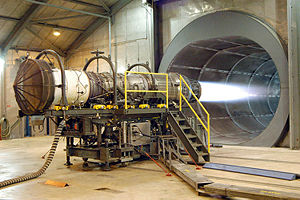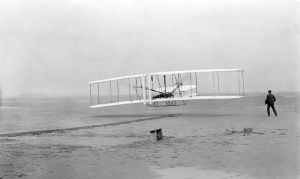Aerospace engineering
Aerospace engineering is the branch of engineering that deals with the design, construction, and science of aircraft and spacecraft. There are two major branches of aerospace engineering: aeronautical engineering and astronautical engineering. The former deals with craft that stay within Earth's atmosphere, and the latter deals with craft that operate outside Earth's atmosphere. Although "aeronautical" was the original term, the broader "aerospace" has superseded it in usage, as flight technology advanced to include craft operating in outer space.[1] On an informal level, aerospace engineering is often called rocket science.
Overview
Modern flight vehicles undergo severe conditions such as differences in atmospheric pressure and temperature, or heavy structural load applied upon vehicle components. Consequently, they are usually the products of various technologies including aerodynamics, avionics, materials science and propulsion. These technologies are collectively known as aerospace engineering. Because of the complexity of the field, aerospace engineering is conducted by a team of engineers, each specializing in their own branches of science.,[2] The development and manufacturing of a flight vehicle demands careful balance and compromise between abilities, performance, available technology and costs.
History
The first controlled hang glider flight was demonstrated by Abbas Ibn Firnas in al-Andalus in the ninth century. In the fifteenth century, Leonardo da Vinci's dream of flight found expression in several designs, but he did not attempt to demonstrate flight.
Sir George Cayley (1773-1857) was an Englishman who pioneered aeronautical engineering in the late eighteenth and early nineteenth centuries. He is remembered for his flying machines, including the working, piloted glider that he designed and built. Experiments with gliders laid the groundwork to build heavier-than-air craft, and by the early twentieth century advancements in engine technology made controlled, powered flight possible for the first time.
An important aviation pioneer was Alberto Santos-Dumont (1873-1932), who designed, built, and flew the first practical dirigible balloons. In so doing, he became the first person to demonstrate that routine, controlled flight was possible. In addition, he made the first public European flight of an airplane in Paris on October 23 1906. That aircraft, designated 14-bis or Oiseau de proie (French for "bird of prey"), is considered by Santos-Dumont supporters to be the first to take off, fly, and land without the use of catapults, high winds, launch rails, or other external assistance.
Early knowledge of aeronautical engineering was largely empirical, with some concepts and skills imported from other branches of engineering.[3] Scientists understood some key elements of aerospace engineering, such as fluid dynamics, in the eighteenth century. Only a decade after the successful flights by the Wright brothers, the 1910s saw the development of aeronautical engineering through the design of World War I military aircraft.
The first definition of aerospace engineering appeared in February 1958.[1] The definition considered the Earth's atmosphere and outer space as a single realm, thereby encompassing both aircraft (aero) and spacecraft (space) under the newly coined word, aerospace. In the United States, the National Aeronautics and Space Administration (NASA) was founded in 1958, as part of the race into space during the Cold War. U.S. aerospace engineers launched the first American satellite on January 31, 1958, in response to the USSR launching of Sputnik.[4]
Elements
Some of the elements of aerospace engineering are:[5][6]
- Fluid mechanics - the study of fluid flow around objects. Specifically aerodynamics concerning the flow of air over bodies such as wings or through objects such as wind tunnels (see also lift and aeronautics).
- Astrodynamics - the study of orbital mechanics including prediction of orbital elements when given a select few variables. While few schools in the United States teach this at the undergraduate level, several have graduate programs covering this topic (usually in conjunction with the Physics department of said college or university).
- Statics and Dynamics (engineering mechanics) - the study of movement, forces, moments in mechanical systems.
- Mathematics - because aerospace engineering heavily involves mathematics.
- Electrotechnology - the study of electronics within engineering.
- Propulsion - the energy to move a vehicle through the air (or in outer space) is provided by internal combustion engines, jet engines and turbomachinery, or rockets (see also propeller and spacecraft propulsion). A more recent addition to this module is electric propulsion.
- Control engineering - the study of mathematical modelling of the dynamic behavior of systems and designing them, usually using feedback signals, so that their dynamic behavior is desirable (stable, without large excursions, with minimum error). This applies to the dynamic behavior of aircraft, spacecraft, propulsion systems, and subsystems that exist on aerospace vehicles.
- Aircraft structures - design of the physical configuration of the craft to withstand the forces encountered during flight. Aerospace engineering aims to keep structures lightweight.
- Materials science - related to structures, aerospace engineering also studies the materials of which the aerospace structures are to be built. New materials with very specific properties are invented, or existing ones are modified to improve their performance.
- Solid mechanics - Closely related to material science is solid mechanics which deals with stress and strain analysis of the components of the vehicle. Nowadays there are several Finite Element programs such as MSC Patran/Nastran which aid engineers in the analytical process.
- Aeroelasticity - the interaction of aerodynamic forces and structural flexibility, potentially causing flutter, divergence, etc.
- Avionics - the design and programming of computer systems on board an aircraft or spacecraft and the simulation of systems.
- Risk and reliability - the study of risk and reliability assessment techniques and the mathematics involved in the quantitative methods.
- Noise control - the study of the mechanics of sound transfer.
- Flight test - designing and executing flight test programs in order to gather and analyze performance and handling qualities data in order to determine if an aircraft meets its design and performance goals and certification requirements.
The basis of most of these elements lies in theoretical mathematics, such as fluid dynamics for aerodynamics or the equations of motion for flight dynamics. However, there is also a large empirical component. Historically, this empirical component was derived from testing of scale models and prototypes, either in wind tunnels or in the free atmosphere. More recently, advances in computing have enabled the use of computational fluid dynamics to simulate the behavior of fluid, reducing time and expense spent on wind-tunnel testing.
Additionally, aerospace engineering addresses the integration of all components that constitute an aerospace vehicle (subsystems including power, communications, thermal control, life support, etc.) and its life cycle (design, temperature, pressure, radiation, velocity, life time).
Aerospace engineering degrees
Aerospace (or aeronautical) engineering can be studied at the advanced diploma, bachelors, masters, and Ph.D. levels in aerospace engineering departments at many universities, and in mechanical engineering departments at others. A few departments offer degrees in space-focused astronautical engineering. The programs of the Massachusettes Institute of Technology and Purdue University College of Engineering are two such examples .[6] US News and World Report ranks the aerospace engineering programs at the Massachusetts Institute of Technology, Georgia Institute of Technology, and the University of Michigan within the top three best programs for doctorate granting universities. However, other top programs within the ten best in the United States include those of Stanford University, Purdue University and the University of Illinois. [7] The magazine also rates Embry-Riddle Aeronautical University, United States Air Force Academy, and Embry-Riddle Aeronautical University in Prescott, AZ as the premier aerospace engineering programs at universities that do not grant doctorate degrees.[8]
Popular culture
The term "rocket scientist" is at times used to describe a person of higher than average intelligence. Aerospace engineering has also been represented as the more "glittery" pinnacle of engineering. The movie Apollo 13 depicts the ground team as a group of heroes in a Hollywood fashion glorifying the intelligence and competence of white shirt and tie professionals. This was later extended in more detail in the spin-off series From the Earth to the Moon.
See also
- Aerodynamics
- Aerospace
- Aviation history
- Fluid dynamics
- Rocket
Notes
- ↑ 1.0 1.1 Stanzione, Kaydon Al. 1989. "Engineering." Encyclopædia Britannica 15th ed. 18:563–563.
- ↑ Career: Aerospace Engineer. Career Profiles. The Princeton Review. Retrieved 2006-10-08.
- ↑ Van Every, Kermit E. 1988. "Aeronautical engineering." Encyclopedia Americana vol. 1. Grolier Incorporated.
- ↑ A Brief History of NASA.
- ↑ "Science: Engineering: Aerospace". Open Site. Retrieved on 2006-10-08.
- ↑ 6.0 6.1 Gruntman, Mike (September 19, 2007). "The Time for Academic Departments in Astronautical Engineering". AIAA SPACE 2007 Conference & Exposition Agenda, AIAA.
- ↑ USNews.com: America's Best Colleges 2008: Aerospace / Aeronautical / Astronautical
- ↑ USNews.com: America's Best Colleges 2008: Aerospace / Aeronautical / Astronautical
ReferencesISBN links support NWE through referral fees
- Newman, Dava. 2001. Interactive Aerospace Engineering and Design. Dubuque, IA: McGraw-Hill. ISBN 0072348208.
- Curtis, Howard. 2004. Orbital Mechanics: For Engineering Students. Atlanta, GA: Butterworth-Heinemann. ISBN 0750661690.
- Sidi, Marcel J. 2000. Spacecraft Dynamics and Control: A Practical Engineering Approach. New York, NY: Cambridge University Press. ISBN 0521550726.
| Types | Major fields of technology | Edit |
|---|---|---|
| Applied Science | Energy storage | Artificial intelligence | Ceramic engineering | Computing technology | Electronics | Energy | Engineering physics | Materials science | Materials engineering | Microtechnology | Nanotechnology | Nuclear technology | Optical engineering | |
| Athletics and Recreation | Camping equipment | Playground | Sports | Sports equipment | |
| The Arts and Language | Communication | Graphics | Music technology | Speech recognition | Visual technology | |
| Business and Information | Construction | Financial engineering | Information technology | Management information systems | Manufacturing | Machinery | Mining | Telecommunication | |
| Military | Bombs | Guns and Ammunition | Military technology and equipment | Naval engineering | |
| Domestic / Residential | Domestic appliances | Domestic technology | Educational technology | Food products and production | |
| Engineering | Agricultural engineering | Bioengineering | Biochemical engineering | Biomedical engineering | Chemical engineering | Civil engineering | Computer engineering | Electrical engineering | Environmental engineering | Industrial engineering | Mechanical engineering | Metallurgical engineering | Nuclear engineering | Petroleum engineering | Software engineering | Structural engineering | |
| Health and Safety | Biomedical engineering | Bioinformatics | Biotechnology | Cheminformatics | Fire protection technology | Health technologies | Pharmaceuticals | Safety engineering | |
| Travel and Trade | Aerospace | Aerospace engineering | Marine engineering | Motor vehicles | Space technology | Transport | |
Template:Academic degrees
Credits
New World Encyclopedia writers and editors rewrote and completed the Wikipedia article in accordance with New World Encyclopedia standards. This article abides by terms of the Creative Commons CC-by-sa 3.0 License (CC-by-sa), which may be used and disseminated with proper attribution. Credit is due under the terms of this license that can reference both the New World Encyclopedia contributors and the selfless volunteer contributors of the Wikimedia Foundation. To cite this article click here for a list of acceptable citing formats.The history of earlier contributions by wikipedians is accessible to researchers here:
The history of this article since it was imported to New World Encyclopedia:
Note: Some restrictions may apply to use of individual images which are separately licensed.


